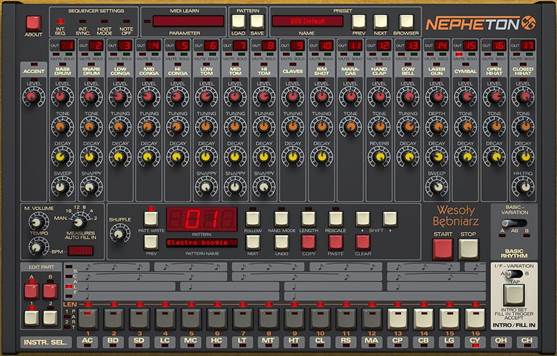Native Instruments – Battery 3
Price: $255
Web: www.native-instruments.com
Format: VST,
AU, RTAS, standalone
NI’s Battery 3 is about as close as you can
get to an industry-standard sample-based drum machine. With an impressive 12GB
library including over 100 kits, ranging from urban and club sounds to pop,
reggae and acoustic, it has many bases covered. The interface itself can be
arranged to have up to 128 pads, and the pads can be made velocity-sensitive
via the onboard mapping grid. Most of the library patches also have velocity
splits.

The
interface itself can be arranged to have up to 128 pads, and the pads can be
made velocity-sensitive via the onboard mapping grid
Battery’s feature set doesn’t extend to
onboard sequencing – in fact, it’s not even capable of recording samples direct
– but it more than makes up for this with a vast range of editing, tweaking and
processing capabilities. Editing for each cell is spread across seven tabbed
pages at the bottom of the screen – Cell, Setup, Mapping, Wave, Loop,
Modulation and Effects. Here you’ll find everything from basic sample volume
envelopes and sample editing to modulation (with an eight-slot router) and
insert effects (six slots). Many of these pages go very deep and include things
such as time stretching, playback articulation scripts, humanize features and
vintage sample playback modes (MPC 60 and SP-1200) – and of course, this is all
done on a cell-by-cell basis. At the master output stage, once again there are
insert effects (three slots) and two global effects (Delay and Reverb), which
you route to from the individual cells. The final page is the Browser, which
allows you to page through individual sounds, audition them and drag-and-drop
them into the cell matrix.

Battery’s
feature set doesn’t extend to onboard sequencing – in fact, it’s not even
capable of recording samples direct
Although Battery 3’s library contains some
pretty high-quality stuff, there is of course nothing to stop you dragging in
your own samples – And this can be a good plan, as Battery’s strength really is
in its ability to manipulate sounds once you get them in. Much like the best
samplers, this is where you can either fine-tune samplers or make them your
own, and the features on offer leave very little reason to apply any further
processing in your DAW. Battery 3 is far more than just a sample playback
engine with a library – it’s a must-have instrument for producing beats.
D16 Group – Drum Machines
Price: $119,
$359 for Classic Boxes
Web: www.d16.pl
Format: VST,
AU
If you spend any amount of time using
classic Roland drum machine sounds such as those of the TR-909, there will come
a moment when working with samples, even carefully produced ones, will begin to
great. This is because the original machines, although limited in terms of
variety, often had quite useful sound-tailoring options, and achieving these
really requires instrument emulation. Thankfully, Poland’s D16 have dedicated
themselves to developing full-on emulations that not only sound but also look
like the originals. The results are Drumazon, Nepheton and Nithonat, which
emulate the TR-909, T-080 and TR-606 respectively.

Nepheton
includes the 16 main sounds found on the 808, plus one more
Each instrument uses the same synthesis and
sound-generating techniques as the original machine, and the layouts are
similar enough to be recognizable to those already familiar with the hardware.
In typical software fashion, however, D16’s virtual versions also expand on the
originals. Nithonat benefits most from this, as the original 606 had limited
sound parameters. Extras include decay, tuning, tone and attack, although not
all sounds get the same controls. There’s also a useful Attack parameter for
the kick and a Snappy control for the snare.
Nepheton includes the 16 main sounds found
on the 808, plus one more. Usefully, the sounds are laid out in separate
columns, rather than with the shared controls found on the original. Once
again, there are some new parameter options, including more extensive decay and
tuning. Finally, Drumazon delivers the 11 sounds of the 909; once again the
layout is a bit more sensible and individual parameters are more extensive than
the original, with six controls for the bass drum, snare and three toms.
Overall, having all three machines at your
disposal provides an enormous palette of classic drum machine sounds. If you
want all three and you have the cash, buying the Classic Boxes bundle, which
also includes D16’s TB-303 Bassline emulation Phoscyon, should sweeten the pill
a little.